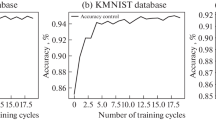Abstract
An approach for the on-line synthesis of wavelet network using recursive least square (RLS) training is proposed. It is based on the concept of successive approximation of the system function to be learned. By using the Bayesian Information Criteria (BIC), the optimal number of wavelets is determined in the training process. Simulation results show that the proposed approach can approximate the unknown system function satisfactorily. Moreover, it can adapt to the changes in system parameters that off-line training cannot.
Similar content being viewed by others
Explore related subjects
Discover the latest articles, news and stories from top researchers in related subjects.References
Q. Zhang and A. Benveniste, “Wavelet networks”, IEEE Trans. NeuralNetworks, Vol. 3, No. 6, pp. 889–898, 1992.
Y. Pati and P. Krishnaprasad, “Analysis and synthesis of feedforward neural networks using discrete affine wavelet transformations”, IEEE Trans. Neural Networks, Vol. 4, No. 1, pp. 73–85, 1993.
B. Bakshi and G. Stephanopoulos, “Wave-net: a multiresolution, hierarchicalneural network with localized learning”, AIChE Journal, Vol. 39, No. 1, pp. 57–81, 1993.
J. Chen and D. Bruns, “WaveARX neural network development for systemidentification using a systematic design synthesis”, Ind. Eng. Chem. Res., Vol. 34, No. 12, pp. 4420–4435, 1995.
L. Wang and G. Libert, “Combining patternrecognition techniques with Akaike's information criteria for identifying ARMA models”, IEEE Trans. Signal Processing, Vol. 42, No. 6, pp. 1388–1396, 1994.
C.S. Leung, K.W. Wong, P.F. Sum, and L.W. Chan, “On-line training and pruning forrecursive least square algorithms”, Electronics Letters, Vol. 32, No. 23, pp. 2152–2153, 1996.
Y. Le Cun, J.S. Denker, and S.A. Solla, “Optimal Brain Damage”, inD.S. Touretzky (ed.), Advances in Neural Information Processing, Vol. 2, pp. 598–605, 1989.
H. Szu, B. Telfer, and S. Kadambe, “Neural network adaptive waveletsfor signal representation and classification”, Optical Engineering, Vol. 31, No. 9, pp. 1907–1916, 1992.
Author information
Authors and Affiliations
Rights and permissions
About this article
Cite this article
Wong, KW., Leung, A.CS. On-line Successive Synthesis of Wavelet Networks. Neural Processing Letters 7, 91–100 (1998). https://doi.org/10.1023/A:1009684412215
Issue Date:
DOI: https://doi.org/10.1023/A:1009684412215




